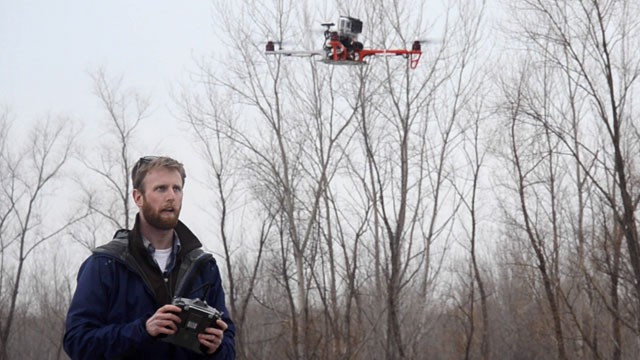 The emergence of UAS journalism is expected to become such a mainstay of the media industry in the next few years that journalism students at the University of Missouri Journalism School, in Columbia, Mo., are now taking courses how to use UAS to report stories.
The emergence of UAS journalism is expected to become such a mainstay of the media industry in the next few years that journalism students at the University of Missouri Journalism School, in Columbia, Mo., are now taking courses how to use UAS to report stories.
“We have a class here of journalism students who are learning to fly J-bots, for journalism robots, or UAS,” said William Allen, a professor of journalism who pioneered the course.
“So they learn to fly them, and also do what reporters do: brainstorm ideas, go out and do reporting, do UAS based photography and video. We’re trying to see if this is going to be useful for journalism,” he said.
The university course emerged from a growing interest in the variety of ways civilians can use UAS, including farmers who want UAS to spray pesticides or monitor crops and livestock on sprawling acres of land; cops who want to use UAS to help search for suspects or missing chidlren; and energy companies who want to keep watch over oil or gas pipelines.
This week, the Senate Judiciary Committee held hearings on the future use of UAS in America, weighing their possible commercial usefulness against privacy concerns. They are expected to lift the current ban on UAS use in populated areas by 2015, and are exploring whether to create new laws by then to govern their use.
“In 2015, when the FAA is set to begin to relax its prohbition on use and integrate civilian use of UAS, then I would think the first folks in the door would be media because there’s such an obvious use,” said Ryan Calo, a law professor at the University of Washington who testified at the Senate hearing.
The University of Missouri course, operating under current FAA regulations, can only use their UAS in rural areas, and so has focused on conservation and agriculture stories, Allen said.
But the leaders of the UAS journalism movement envision a time when news organizations replace costly helicopters and pilots with cheap UAS to get closer to breaking news or weather stories, along with using them to uncover investigative pieces they may normally not see.
“The other aspect is investigative, the idea is you put a UAS up in the air and look around. Maybe you’ll find things, who knows what yet,” Allen said. “We need to explore that and see. Many journalists can’t afford to rent a helicopter and fly around.”
A group of Pakistani journalists who visited Allen’s course noted that they would want to use UAS to act as first responders to terrorist bomb explosions in Pakistan, rather than risk sending reporters there only to have a second bomb go off moments later.
The information captured on cameras, however, is exactly what leaves many Americans feeling unsettled when it comes to civilian UAS use, Pham and Calo said. Many people are uncomfortable with the idea of unmanned, tiny helicopters circling over their homes and yards, snapping photos of them.
Snapping photos also raises the spectre of using UAS to chase down people in the news, especially celebrities.
“I worry about UAS paparazzi,” Calo said. “For celebrities, obviously it’s a burden they must bear for being in the public eye, but the possibility of constant surveillance and possible danger to a celebrity I think are real concerns.”
Allen and Pham, along with experts at the University of Illinois and University of Nebraska who study UAS use in journalism, said that they hope regulations will allow for the use of UAS in journalism without invasions of privacy.
“I just hope people will not throw the baby out with the bathwater,” Allen said, “the baby here is the great benefit of using UAS, and the bathwater is the dirty stuff about privacy concerns.”
“But part of my job is to get students ready to go into these news organizations, and to know how to fly and do a story safely, legally, ethically, and responsibly, and tell stories that way. I think there will be a demand for it, just like any technology in the journalism tool box,” he said.
Source: ABC News
